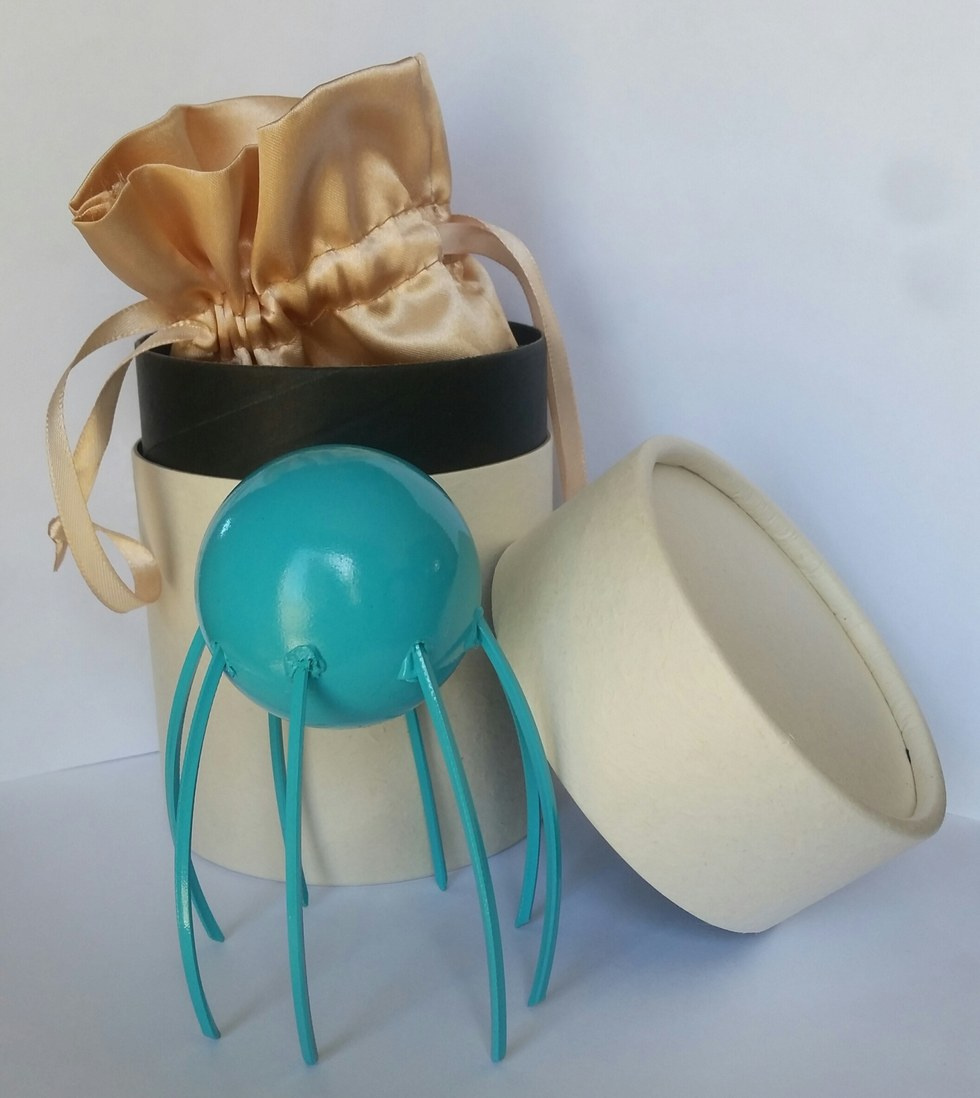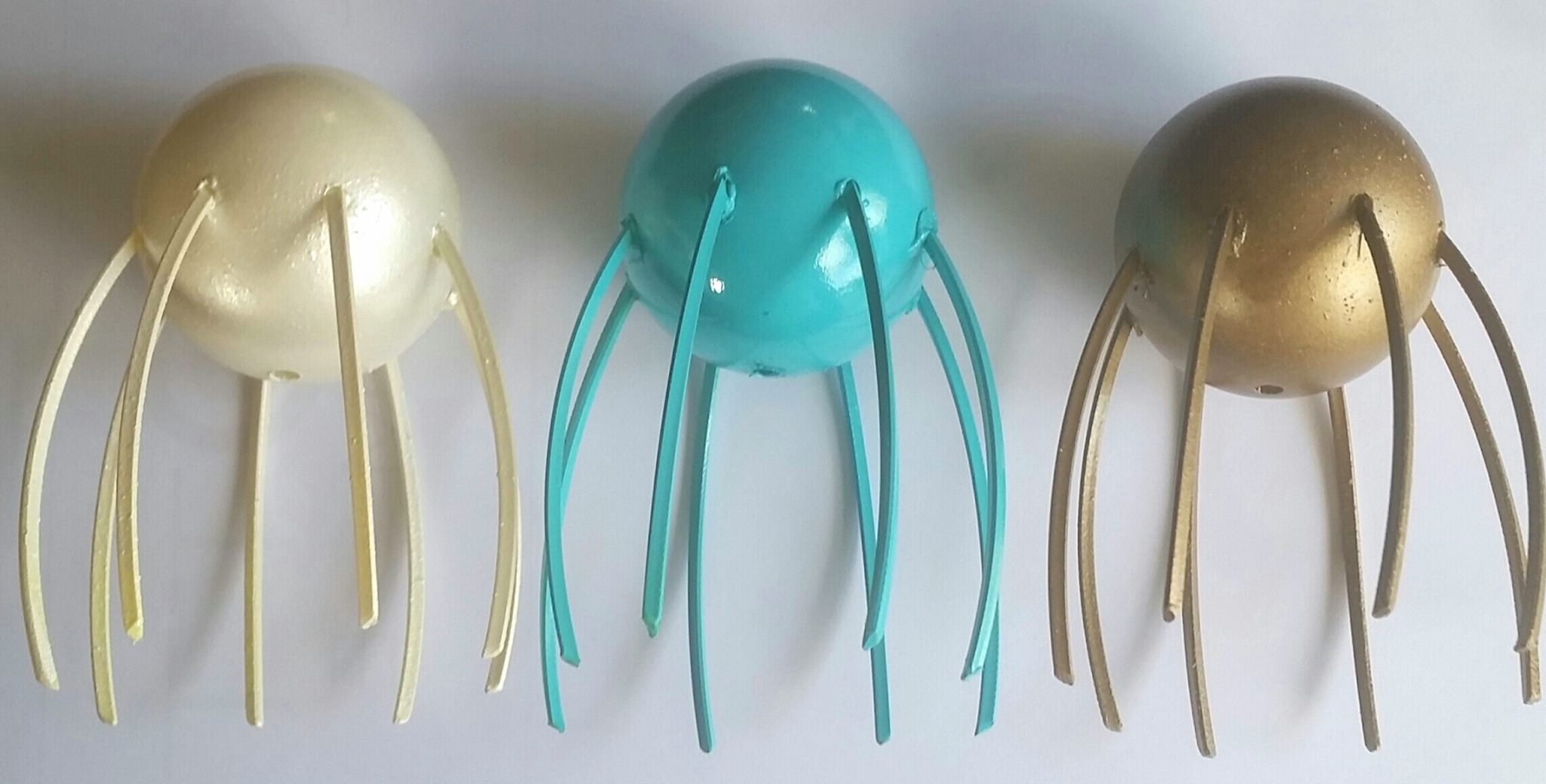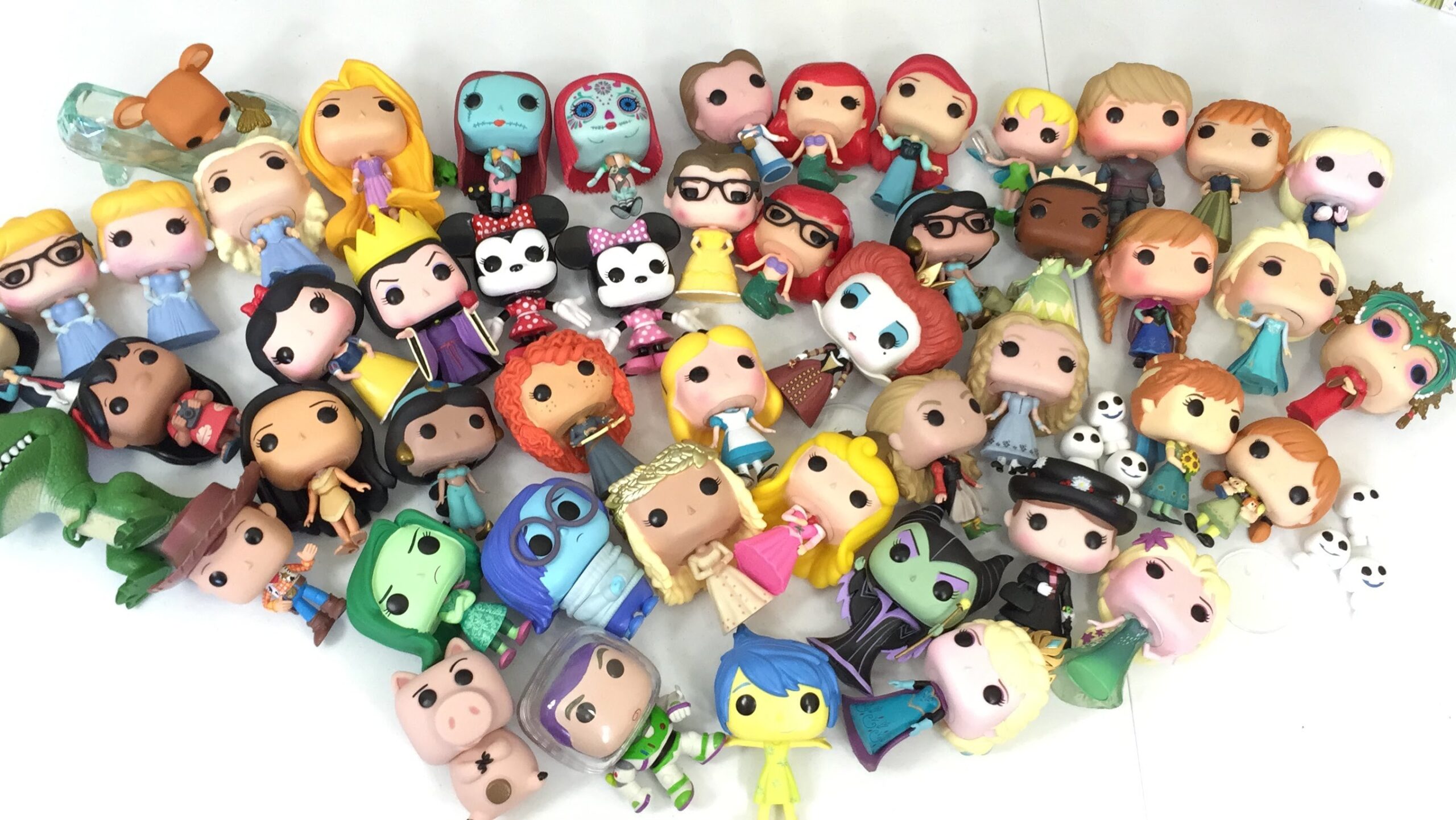I recently had the pleasure to conduct a Q & A with the amazing Tricia Scribner, Creator of Knotty Tamer. This unique hair detangler solves the problem those with long hair, no matter the texture, have been dealing with since the beginning of time – knots and tangles that just won’t quit.
Knotty Tamer is not like an ordinary comb or brush which can cause breakage and even make the issue worse. Instead, it deals with knots and tangles faster, with little to no damage. After years of struggling herself, Tricia conceptualized a new idea, and after lots of dedication, hard work, and the drive to make her idea a tangible product, Knotty Tamer was born. Her hair has never looked better, and for those seeking the same, Knotty Tamer will be their solution too!
Here, Tricia answers questions about her start, her highs and lows, what it takes to make it as an inventor, and advice only someone who has “been there, done that” can offer. And learn what makes Knotty Tamer the mane solution for those pesky knots and tangles!
(adsbygoogle = window.adsbygoogle || []).push({});
 Tricia Scribner
Tricia Scribner
Q: When did you first realize you wanted to be an entrepreneur and what was your first endeavor?
A: I think I’ve always known I wanted to be an entrepreneur since a very young age. If I wanted something, I figured out how to get it by raising capital. If I needed some Christmas money, I would literally work with what was around me, like make ornaments from cones on trees, glue them together, make a wreath, and go door to door, and I’d sell some. Or I would make things to put in my grandma’s antique stores to sell, or mow my neighbor’s lawn to earn money for a dog. I did these things since I was around 8. We charged kids a nickel or quarter to watch little plays we’d make up. I placed a value on everything.
As I got older I would come up with ideas that either solved problems, or were new ideas and I am so glad I didn’t pursue them all or I would be dead broke! The key to knowing which idea to run with is knowing that it will truly be worth the money, will make money, will solve a problem, and that there is nothing like yours out there.
Q: How did the idea for Knotty Tamer come about?
A: My hair has always been quickly tangled, hard to get through, you name it. Most things on the market are just another version of the same thing already out there and still doesn’t address the tangle differently. I had been working on a detangler for many years, from solutions, to different tool ideas, sketches… it just took me closely examining an actual knot/tangle and understanding how it got there and how I think I could get it out better, quickly and with less breakage.
I knew I had an idea and off to Home Depot, Michael’s, and back to Home Depot and several visits and aisles later with additional online research, I was onto something. I recommend always looking outside of your industry, look at industrial websites for materials, other industries, you’d be surprised. It took a few attempts a few months apart, but I finally had my first working prototype!
Q: What has been your biggest challenge with the product/company thus far?
A: The biggest challenge has truly been finding an injection mold maker. There are a lot of them out there, but they cost a lot, and your CAD design, which you will need, can also be costly. I’m someone who likes to look you in the eyes and meet face to face to discuss my ideas, and most of the makers I had found were online, costly but quick, but in another state. I did look locally but I hadn’t found one. Then my boyfriend saw the trouble I was having and came up with a few contacts for me locally and it wasn’t easy, nor on the timelines I was hoping for, but we finally got there and working on full production.
My biggest lesson here was thinking I could have this done so quickly. Most entrepreneurs think big, so we have it in our heads that we will be to market selling in XYZ amount of time, and the most crucial time spent is getting your actual product done right. You must allow time for changes, communication, things out of your control, mistakes, etc. Double or triple your time if you must, and this was a hard lesson because I was ready to pounce. However, I am right where I am supposed to be currently, it all aligned up, I found the best packaging company to work with, and I couldn’t imagine having my product sooner at this point, so trust the process and stay vigilant.
(adsbygoogle = window.adsbygoogle || []).push({});
Q: What has been the most rewarding experience throughout the process?
A: Besides my friends loving how the Knotty Tamer functions and response to some pre-sales and stop-ins, I’d have to say the most rewarding experience was finally seeing the actual product produced from the injection mold itself. It still needed some minor tweaks, but overall, I’m thrilled! To see your idea go from your little glued-together prototype to a fully functioning live product, priceless!
Q: What is different about your invention compared to other products in its category?
A: The Knotty Tamer is unique, it’s not a brush, it’s not a comb, It’s completely different in how it functions, is held, used… it attacks the tangle right where it’s at, versus your typical product that just moves the tangle around, compacts it, and tends to break your hair in the process. The Knotty Tamer looks different, is held different, and goes through hair differently, and removes knots and tangles quickly with little to no breakage. Most people think I have extensions because my hair is in such good condition, and I see their frayed ends, and if they had my product, they could save those ends.
Q: How were you able to finance the development and launch of the company?
A: I finally created Knotty Tamer while I was already self-employed and went with it, I don’t advise that, but you never know when you’ll invent something. I have had to utilize many sources of income from my other business, credit cards, savings, family, friends, garage sales, loans, you name it! Of course, planning and preparing is essential and practical, but much of entrepreneurship is risk, and you have to learn the highs and lows and quite honestly embrace it.
Q: Where can people purchase your product?
A: For now it can be purchased on knottytamer.com but will soon be in select beauty retailers, salons, suppliers, etc. Truly, it’s limitless where we will be, in the hands of people with knots and tangles is the best spot!
Q: Where do you see the company going in the future?
A: I definitely have more products to add to the line and I am excited about that. I want to make sure we are continually solving a problem for people because I understand the frustration, and unfortunately there is no one-size-fits-all product, but I want to help as many people as I can to get ready faster and have healthy hair.
I do see opportunities for private labeling, licensing agreements, growing and selling the brand – that’s what pretty much everyone wants!
(adsbygoogle = window.adsbygoogle || []).push({});
Q: What advice would you give a budding entrepreneur seeking to launch a new product or service?
A: This whole interview could have been based on this one question, I have so much advice! I truly feel anyone can invent something, just figure out how to solve a problem that is viable, but from that point on is where I think it’s tricky, not everyone is cut out to see it through, you have to know your skill sets and be willing to learn new ones. That can be hard sometimes, it’s uncomfortable. I’ve taught myself a lot because I am naturally curious so I learned trademark laws, patent laws, how to seek out packaging and create it, create logos, etc. I have an excellent graphic guy who understands me, I would have been a great graphic artist but I am not about to take classes at this point, so I have a great guy. I paid way too much for my first website for another business, and a boyfriend told me to use a different platform so I could be in charge. I was hesitant at first, but then I went for it and learned so much about the design. I am now in control and it’s great.
Don’t buy into the lies of overnight online success! While timing is important, it’s more important to know how to grow your business sustainably. There is a right time to know when to pull the trigger on paying for online ads, and the more you can do in the beginning yourself the better so you learn it! You can create beautiful ads with sites like Canva.com, write your own content, etc.
Learn to run as lean as you can for as long as you can, use your garage, spare room, don’t even think about office space until you have truly outgrown your current situation. Cook or learn to cook before Top Ramen becomes a food group! This is not a time to be prideful, you may need a business loan or to raise capital, borrow from family or friends, or keep your job until you can truly self-fund your business. This can be the most exciting time of your life and truly the most frightening, I prayed a lot and believe in prayer, lots of prayer!
Q: How many people work for the company at this time?
A: It is still just me. I will operate alone as long as possible with hiring on a contract basis, commission, people willing to help me with their time in the early stage, and make sure that when I do need to pay or hire that it truly brings an ROI. Again, running lean as long as possible or sustainable!
Q: Sum up your company philosophy (or your own personal “mantra”) in 3 words:
A: For me personally, “Make It Happen.” I try to live by that.
Q: What about your personality makes you a successful entrepreneur?
A: I’m still finding my way through success, but I believe what makes me think I can be successful is that I don’t give up. I see the big picture and I’m extremely resourceful. My optimism can also cause some of my biggest issues, but I always find a way. With social media, you have to truly self-promote and this is something I am not comfortable with, but learning to be. I like to stay private, although most think I am extroverted, I’m probably more of an introverted extrovert. I need downtime to create and think up these ideas. So, I am learning to be out there more and open to promote my brand. I’ve spent my entire career in sales, so now it’s my turn!
Q: Anything else you’d like to share?
Yes, so much more to share, but I will keep it simple. Be careful who you get advice or opinions from, because it can throw you off. Advice from people close to you, experts, people who have been there is great. Don’t stress yourself out with the competition, be aware, but focus on your journey and how to get there, you can do this! Be willing to do what others won’t, this isn’t for everyone. Have someone close to confide in as you will most likely be spending a lot of time alone in the beginning while you start up. There are many ways to make money, find your niche and God Bless!

Knotty Tamer will change the way people with long hair (even extensions) detangle. Quick, easy, pain-free, and less damaging, this new product is the future of hair care!
string(12556) "
I recently had the pleasure to conduct a Q & A with the amazing Tricia Scribner, Creator of Knotty Tamer. This unique hair detangler solves the problem those with long hair, no matter the texture, have been dealing with since the beginning of time – knots and tangles that just won't quit.
Knotty Tamer is not like an ordinary comb or brush which can cause breakage and even make the issue worse. Instead, it deals with knots and tangles faster, with little to no damage. After years of struggling herself, Tricia conceptualized a new idea, and after lots of dedication, hard work, and the drive to make her idea a tangible product, Knotty Tamer was born. Her hair has never looked better, and for those seeking the same, Knotty Tamer will be their solution too!
Here, Tricia answers questions about her start, her highs and lows, what it takes to make it as an inventor, and advice only someone who has "been there, done that" can offer. And learn what makes Knotty Tamer the mane solution for those pesky knots and tangles!
(adsbygoogle = window.adsbygoogle || []).push({});
 Tricia Scribner
Tricia Scribner
Q: When did you first realize you wanted to be an entrepreneur and what was your first endeavor?
A: I think I've always known I wanted to be an entrepreneur since a very young age. If I wanted something, I figured out how to get it by raising capital. If I needed some Christmas money, I would literally work with what was around me, like make ornaments from cones on trees, glue them together, make a wreath, and go door to door, and I'd sell some. Or I would make things to put in my grandma's antique stores to sell, or mow my neighbor's lawn to earn money for a dog. I did these things since I was around 8. We charged kids a nickel or quarter to watch little plays we'd make up. I placed a value on everything.
As I got older I would come up with ideas that either solved problems, or were new ideas and I am so glad I didn't pursue them all or I would be dead broke! The key to knowing which idea to run with is knowing that it will truly be worth the money, will make money, will solve a problem, and that there is nothing like yours out there.
Q: How did the idea for Knotty Tamer come about?
A: My hair has always been quickly tangled, hard to get through, you name it. Most things on the market are just another version of the same thing already out there and still doesn't address the tangle differently. I had been working on a detangler for many years, from solutions, to different tool ideas, sketches... it just took me closely examining an actual knot/tangle and understanding how it got there and how I think I could get it out better, quickly and with less breakage.
I knew I had an idea and off to Home Depot, Michael's, and back to Home Depot and several visits and aisles later with additional online research, I was onto something. I recommend always looking outside of your industry, look at industrial websites for materials, other industries, you'd be surprised. It took a few attempts a few months apart, but I finally had my first working prototype!
Q: What has been your biggest challenge with the product/company thus far?
A: The biggest challenge has truly been finding an injection mold maker. There are a lot of them out there, but they cost a lot, and your CAD design, which you will need, can also be costly. I'm someone who likes to look you in the eyes and meet face to face to discuss my ideas, and most of the makers I had found were online, costly but quick, but in another state. I did look locally but I hadn't found one. Then my boyfriend saw the trouble I was having and came up with a few contacts for me locally and it wasn't easy, nor on the timelines I was hoping for, but we finally got there and working on full production.
My biggest lesson here was thinking I could have this done so quickly. Most entrepreneurs think big, so we have it in our heads that we will be to market selling in XYZ amount of time, and the most crucial time spent is getting your actual product done right. You must allow time for changes, communication, things out of your control, mistakes, etc. Double or triple your time if you must, and this was a hard lesson because I was ready to pounce. However, I am right where I am supposed to be currently, it all aligned up, I found the best packaging company to work with, and I couldn't imagine having my product sooner at this point, so trust the process and stay vigilant.
(adsbygoogle = window.adsbygoogle || []).push({});
Q: What has been the most rewarding experience throughout the process?
A: Besides my friends loving how the Knotty Tamer functions and response to some pre-sales and stop-ins, I'd have to say the most rewarding experience was finally seeing the actual product produced from the injection mold itself. It still needed some minor tweaks, but overall, I'm thrilled! To see your idea go from your little glued-together prototype to a fully functioning live product, priceless!
Q: What is different about your invention compared to other products in its category?
A: The Knotty Tamer is unique, it's not a brush, it's not a comb, It's completely different in how it functions, is held, used... it attacks the tangle right where it's at, versus your typical product that just moves the tangle around, compacts it, and tends to break your hair in the process. The Knotty Tamer looks different, is held different, and goes through hair differently, and removes knots and tangles quickly with little to no breakage. Most people think I have extensions because my hair is in such good condition, and I see their frayed ends, and if they had my product, they could save those ends.
Q: How were you able to finance the development and launch of the company?
A: I finally created Knotty Tamer while I was already self-employed and went with it, I don't advise that, but you never know when you'll invent something. I have had to utilize many sources of income from my other business, credit cards, savings, family, friends, garage sales, loans, you name it! Of course, planning and preparing is essential and practical, but much of entrepreneurship is risk, and you have to learn the highs and lows and quite honestly embrace it.
Q: Where can people purchase your product?
A: For now it can be purchased on knottytamer.com but will soon be in select beauty retailers, salons, suppliers, etc. Truly, it's limitless where we will be, in the hands of people with knots and tangles is the best spot!
Q: Where do you see the company going in the future?
A: I definitely have more products to add to the line and I am excited about that. I want to make sure we are continually solving a problem for people because I understand the frustration, and unfortunately there is no one-size-fits-all product, but I want to help as many people as I can to get ready faster and have healthy hair.
I do see opportunities for private labeling, licensing agreements, growing and selling the brand - that's what pretty much everyone wants!
(adsbygoogle = window.adsbygoogle || []).push({});
Q: What advice would you give a budding entrepreneur seeking to launch a new product or service?
A: This whole interview could have been based on this one question, I have so much advice! I truly feel anyone can invent something, just figure out how to solve a problem that is viable, but from that point on is where I think it's tricky, not everyone is cut out to see it through, you have to know your skill sets and be willing to learn new ones. That can be hard sometimes, it's uncomfortable. I've taught myself a lot because I am naturally curious so I learned trademark laws, patent laws, how to seek out packaging and create it, create logos, etc. I have an excellent graphic guy who understands me, I would have been a great graphic artist but I am not about to take classes at this point, so I have a great guy. I paid way too much for my first website for another business, and a boyfriend told me to use a different platform so I could be in charge. I was hesitant at first, but then I went for it and learned so much about the design. I am now in control and it's great.
Don't buy into the lies of overnight online success! While timing is important, it's more important to know how to grow your business sustainably. There is a right time to know when to pull the trigger on paying for online ads, and the more you can do in the beginning yourself the better so you learn it! You can create beautiful ads with sites like Canva.com, write your own content, etc.
Learn to run as lean as you can for as long as you can, use your garage, spare room, don't even think about office space until you have truly outgrown your current situation. Cook or learn to cook before Top Ramen becomes a food group! This is not a time to be prideful, you may need a business loan or to raise capital, borrow from family or friends, or keep your job until you can truly self-fund your business. This can be the most exciting time of your life and truly the most frightening, I prayed a lot and believe in prayer, lots of prayer!
Q: How many people work for the company at this time?
A: It is still just me. I will operate alone as long as possible with hiring on a contract basis, commission, people willing to help me with their time in the early stage, and make sure that when I do need to pay or hire that it truly brings an ROI. Again, running lean as long as possible or sustainable!
Q: Sum up your company philosophy (or your own personal "mantra") in 3 words:
A: For me personally, "Make It Happen." I try to live by that.
Q: What about your personality makes you a successful entrepreneur?
A: I'm still finding my way through success, but I believe what makes me think I can be successful is that I don't give up. I see the big picture and I'm extremely resourceful. My optimism can also cause some of my biggest issues, but I always find a way. With social media, you have to truly self-promote and this is something I am not comfortable with, but learning to be. I like to stay private, although most think I am extroverted, I'm probably more of an introverted extrovert. I need downtime to create and think up these ideas. So, I am learning to be out there more and open to promote my brand. I've spent my entire career in sales, so now it's my turn!
Q: Anything else you'd like to share?
Yes, so much more to share, but I will keep it simple. Be careful who you get advice or opinions from, because it can throw you off. Advice from people close to you, experts, people who have been there is great. Don't stress yourself out with the competition, be aware, but focus on your journey and how to get there, you can do this! Be willing to do what others won't, this isn't for everyone. Have someone close to confide in as you will most likely be spending a lot of time alone in the beginning while you start up. There are many ways to make money, find your niche and God Bless!

Knotty Tamer will change the way people with long hair (even extensions) detangle. Quick, easy, pain-free, and less damaging, this new product is the future of hair care!
"

 Tricia Scribner
Tricia Scribner











